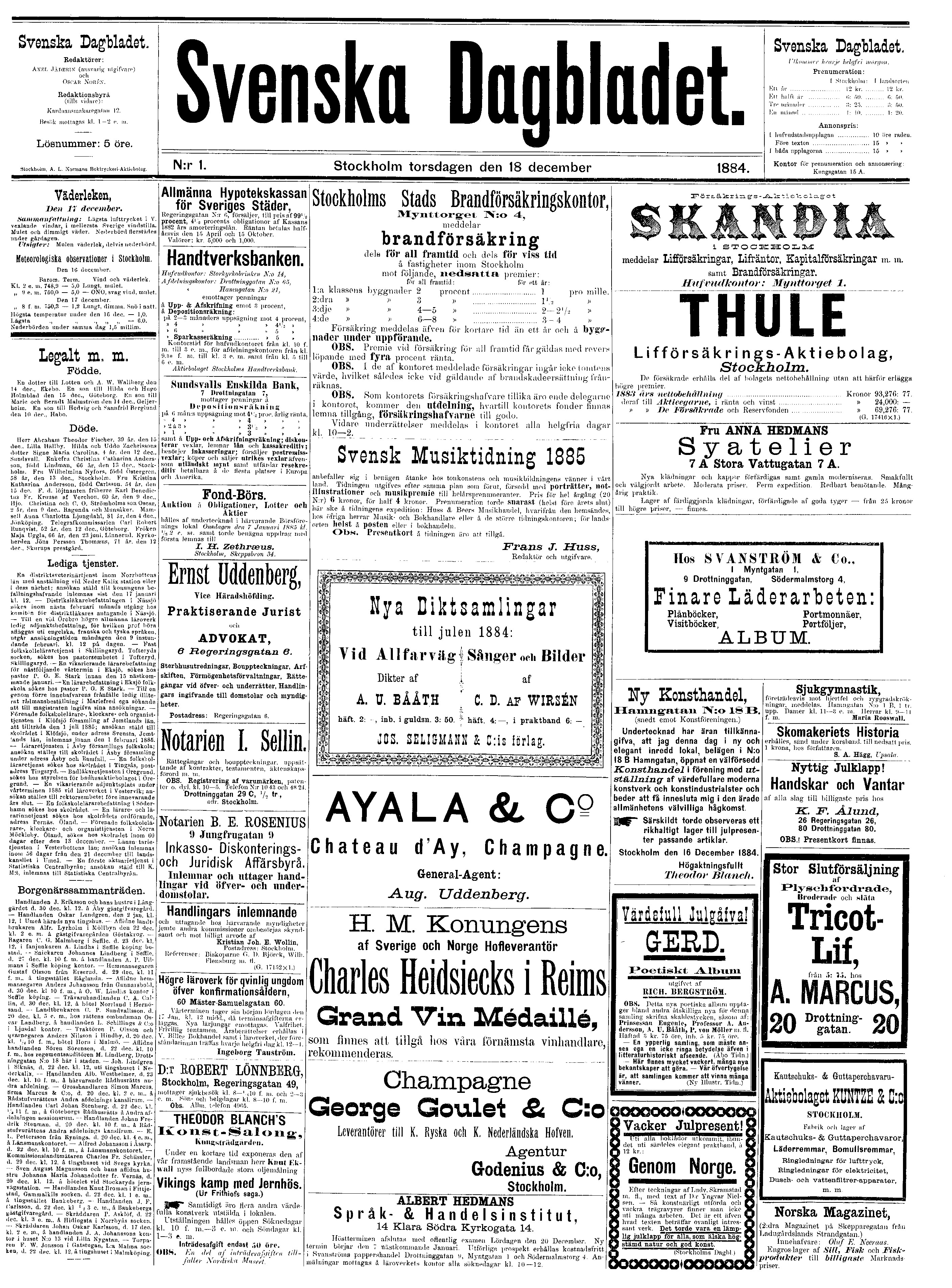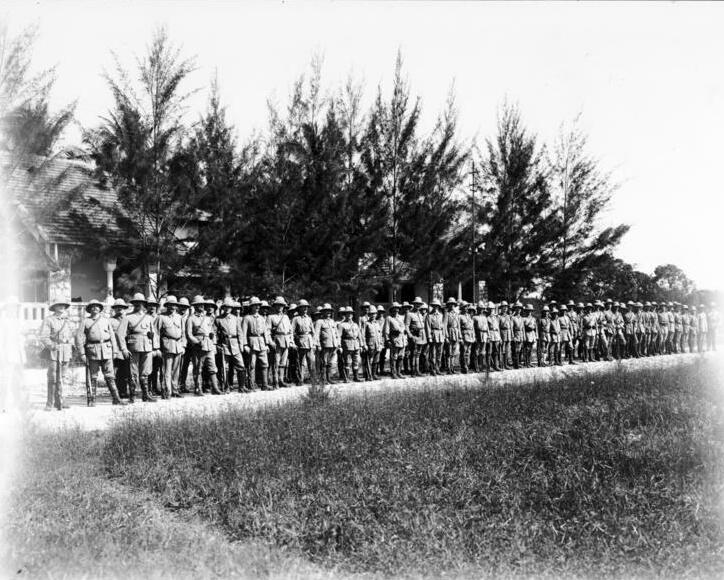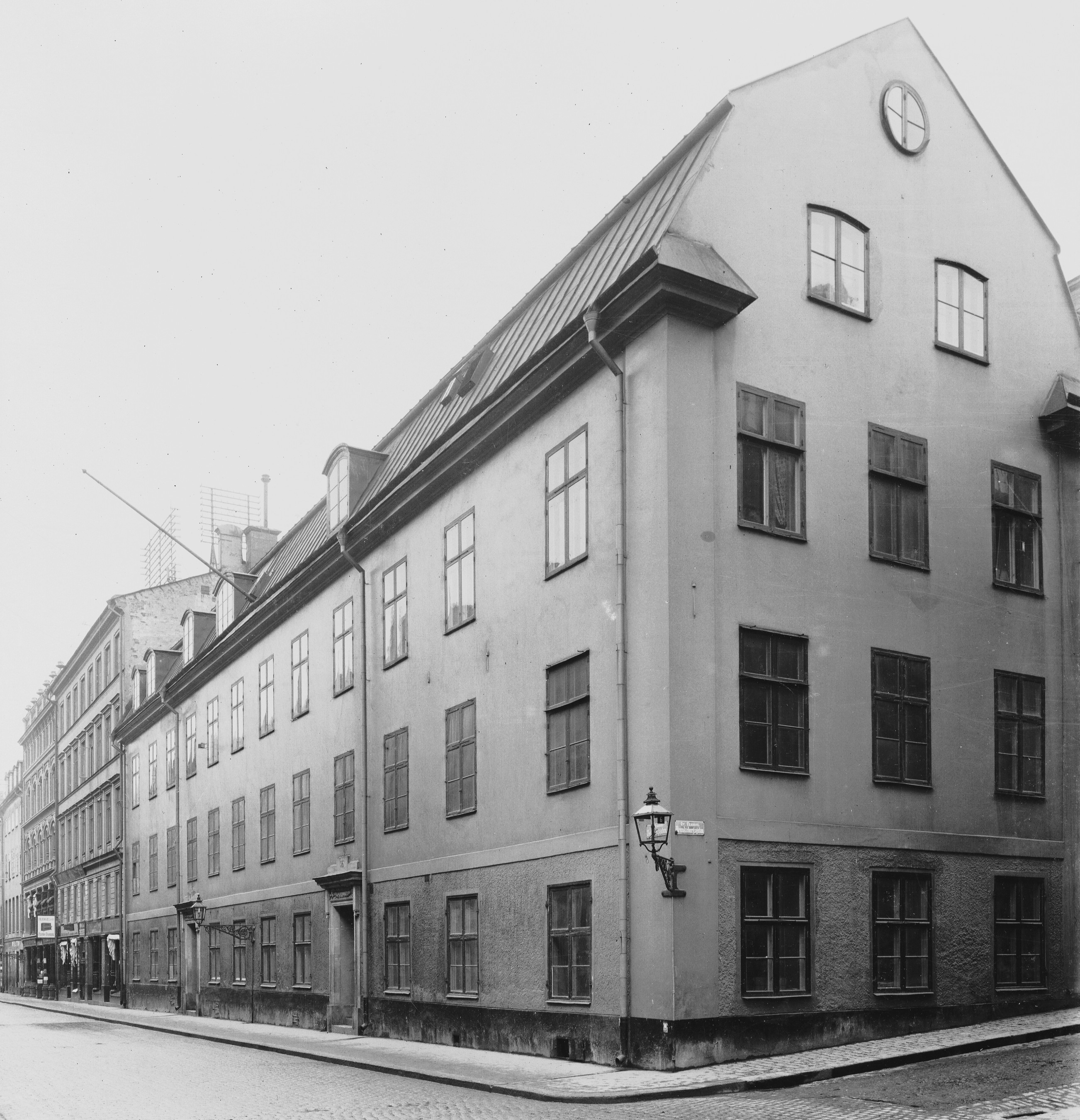|
Carl Warberg
Lieutenant General Casten Abraham ''Carl'' Warberg (2 December 1845 – 16 October 1910) was a Swedish Army officer. His senior commands include commanding officer of the 4th and 6th Army Divisions. Warberg also served as Acting Chief of the General Staff and as Commandant General in Stockholm. He was also the chief of His Majesty's Military Staff. Early life Warberg was born on 2 December 1845 in Värmdö Municipality, Sweden. Warberg was commissioned as an officer in 1864 in 2nd Life Guards (''Andra livgardet'') with the rank of ''underlöjtnant''. Career Warberg attended the Royal Swedish Army Staff College in 1867 and was promoted to lieutenant the year after. In 1871 he was appointed general staff officer and was in 1874 appointed staff adjutant and lieutenant in the General Staff as well as to captain there in 1875. In 1877 he served a military attaché for six months in the Russian Army of the Danube during the Russo-Turkish War. Warberg was then stationed partly at the ... [...More Info...] [...Related Items...] OR: [Wikipedia] [Google] [Baidu] |
Värmdö Municipality
Värmdö Municipality (''Värmdö kommun'') is a municipality in Stockholm County in east central Sweden. Its seat is in the town of Gustavsberg, with a population of 9,682 (2005), on the main island at an elevation of . The municipality is named after the main island Värmdön, in size. The municipality in its present form was created in 1974, when "old" Värmdö was amalgamated with Gustavsberg (which had been detached from it in 1902) and Djurö. Geography The municipality consists of 10,000 islands, all part of Stockholm archipelago. The larger islands are Värmdö, Ingarö, Fågelbrolandet, Djurö/Vindö, Svartsö, Möja, Runmarö and Nämdö. Gustavsberg is the main town, and there are also several villages and suburbs spread out such as Djurö, Stavsnäs, Mörtnäs, Hemmesta, Brunn, Strömma and Sandhamn. History The name Värmdö can be traced to 1314, but it is not clear what it means. (It is likely that it comes from the word ''värmd'', a small hot spring i ... [...More Info...] [...Related Items...] OR: [Wikipedia] [Google] [Baidu] |
9th Army Corps (Russian Empire)
The 9th Army Corps was an Army corps in the Imperial Russian Army. Composition * 5th Infantry Division * 42nd Infantry Division * 9th Cavalry Division Part of * 3rd Army: 1914–1916 * 4th Army: 1916 *3rd Army: 1916 *4th Army: 1916 * 2nd Army: 1916–1917 Commanders *1877–1878: Nikolay Kridener *1878–1886: Arkady Dmitrievich Stolypin *1912–1915: Dmitry Shcherbachev *1915–1916: Abram Dragomirov *1916-April 1917 : Nikolay Kiselevsky *May–September 1917: Pyotr Telezhnikov Pyotr Dmitryvich Telezhnikov (birth surname Schreider; born 31 March 1863) was an Imperial Russian division, corps and army commander. He was made a Poruchik in 1886, a Stabskapitän in 1890, a captain in 1892, a Podpolkovnik (lieutenant colonel) ... *September-November 1917: Andrey Snesarev {{russia-hist-stub Corps of the Russian Empire Military units and formations established in 1876 Military units and formations disestablished in 1918 1876 establishments in the Russian Empire ... [...More Info...] [...Related Items...] OR: [Wikipedia] [Google] [Baidu] |
Överstelöjtnant
Lieutenant colonel (LtCol) ( sv, Överstelöjtnant, Övlt) is a field grade officer rank in the Swedish Armed Forces, just above the rank of major and just below the rank of colonel. It is equivalent to the naval rank of commander in the Swedish Navy. History Lieutenant colonel denotes the closest below the colonel's regimental officer rank. The term is almost as old as colonel and initially referred to his closest aides. Nowadays, the lieutenant colonel in a regiment in most armies has become the colonel's closest assistant. In Sweden, in peacetime he is sometimes battalion commander; in war as well as during major troop exercises he often commands regiments. Lieutenant colonels serves as commanding officer of a battalion or second-in-command of a brigade. As staff officers, lieutenant colonels serves as section heads, heads of function or qualified staff officer. Lieutenant colonels belong to skill levels C (Advanced) or D (Expert). Rank insignia Collar patches File: ... [...More Info...] [...Related Items...] OR: [Wikipedia] [Google] [Baidu] |
Major (Sweden)
Major (Maj) ( sv, Major, Mj) is a field grade military officer rank in the Swedish Armed Forces, above the rank of captain and below the rank of lieutenant colonel. It is equivalent to the naval rank of lieutenant commander in the Swedish Navy. History The rank of major was introduced in the middle of the 16th century in the Spanish and German armies, and its holders were assigned to the regimental commander. After the introduction of the battalion division, the major was eventually given command of a battalion in all armies, as was the lieutenant colonel. After the division of the regiment was established in Sweden in 1634, each regiment with regimental officers had a colonel (regimental commander), a lieutenant colonel and a major, of whom the latter often commanded the colonel's battalion. Like the 2nd major added in 1757 and the 3rd major added later in several regiments, the major had company commanders position until the 1833 pay regulation. All the regimental officers, wit ... [...More Info...] [...Related Items...] OR: [Wikipedia] [Google] [Baidu] |
Kapten
''Kapten'' ( en, Captain in the Swedish Army/ Air Force, ''Lieutenant'' in the Navy) is a company grade officer rank. In the army/airforce, it ranks above lieutenant and below major. In the navy, it ranks above sub-lieutenant and below lieutenant commander. It is equivalent to the specialist officers rank of '' förvaltare''. The rank has been used in Sweden since the Middle Ages. Army/Air Force/Navy ''Kapten'' (captain) is a rank in the Swedish Army, Swedish Air Force and in the Swedish Navy (Coastal Artillery 1902–2000, Amphibious Corps 2000–present). History A ''kapten'' (captain) usually commanded an infantry company or an artillery battery. The name appeared quite early in the Middle Ages and then applied to the highest commander in an area, a city etc. With the standing armies, which began to be established in the latter half of the 15th century, it was the name of the commander of a unit in both the infantry and the cavalry, which unit was first called comp ... [...More Info...] [...Related Items...] OR: [Wikipedia] [Google] [Baidu] |
Löjtnant
''Löjtnant'' ( en, Lieutenant in the Swedish Army/Air Force, Sub-lieutenant in the Navy) is a company grade officer rank. In the army/airforce, it ranks above second lieutenant and below captain. In the navy, it ranks above acting sub-lieutenant and below lieutenant. It is equivalent to the specialist officers rank of '' förvaltare''. The rank has been used in Sweden since the Middle Ages. Army/Air Force/Navy ''Löjtnant'' (lieutenant) is a rank in the Swedish Army, Swedish Air Force and in the Swedish Navy (Coastal Artillery 1902–2000, Amphibious Corps 2000–present). History The rank of ''löjtnant'' (lieutenant) appears for the first time during the latter part of the Middle Ages. Originally, it designated the (commander's) deputy, of which the compositions were lieutenant general, lieutenant colonel and captain lieutenant, and sometimes also the lowest commander's deputy. Eventually the word changed to refer exclusively to the company commander's deputy, and even ... [...More Info...] [...Related Items...] OR: [Wikipedia] [Google] [Baidu] |
Underlöjtnant
''Underlöjtnant'' (from the German word ''Unterleutnant'') was the lowest officer rank in the Swedish Army from 1835 to 1937 instead of the previous ranks of ''fänrik'' and cornet. was reintroduced in 1914 with the same position as , from 1926 with lower position. History was introduced as a military rank in Sweden in 1835 instead of ''fänrik''. '' Fanjunkare'', who served with distinction, was often promoted after leaving active service to in the Swedish Army. With the 1914 Army Order, Naval Plan and Plan for the Fixed Coastal Defence Organization (), the rank of was reintroduced as a name for a newly commissioned officer, who completed two years of probationary service. The would have s position and salary benefits but be appointed by Warrant of Appointment. The Minister of Defence proposed (Bill 1924:20) that certain should receive a rank above the rank of - with the position of ''löjtnant''. They would be called ("second lieutenants"). would receive the rank of ... [...More Info...] [...Related Items...] OR: [Wikipedia] [Google] [Baidu] |
Svenska Dagbladet
''Svenska Dagbladet'' (, "The Swedish Daily News"), abbreviated SvD, is a daily newspaper published in Stockholm, Sweden. History and profile The first issue of ''Svenska Dagbladet'' appeared on 18 December 1884. During the beginning of the 1900s the paper was one of the right-wing publications in Stockholm. Ivar Anderson is among its former editors-in-chief who assumed the post in 1940. The same year ''Svenska Dagbladet'' was sold by Trygger family to the Enterprise Fund which had been established by fourteen Swedish businessmen to secure the ownership of the paper. The paper is published in Stockholm and provides coverage of national and international news as well as local coverage of the Greater Stockholm region. Its subscribers are concentrated in the capital, but it is distributed in most of Sweden. The paper was one of the critics of the Prime Minister Olof Palme, and in December 1984 it asked him to resign from the office following his interview published in '' ... [...More Info...] [...Related Items...] OR: [Wikipedia] [Google] [Baidu] |
Landsturm
In German-speaking countries, the term ''Landsturm'' was historically used to refer to militia or military units composed of troops of inferior quality. It is particularly associated with Kingdom of Prussia, Prussia, German Empire, Germany, Austria-Hungary, Sweden and the Netherlands. Austria-Hungary The Austria-Hungary, Austro-Hungarian ''Landsturm'' was a Military reserve force, reserve force that consisted of men aged 34 to 55. It was intended to provide replacements for the front line units and provide a militia for local defense. It was divided into the Austrian Imperial (Kaiserlich und Königlich, Kaiserlich) ''Landsturm'' and the Hungarian Royal (Kaiserlich und Königlich, Königlich) ''Népfelkelés''. During the First World War, the Austrian Landsturm formed 40 regiments totaling 136 battalions in Austria and the Hungarian Landsturm formed 32 regiments totaling 97 battalions. They provided 20 Brigades who took to the field with the rest of the army. Germany Pr ... [...More Info...] [...Related Items...] OR: [Wikipedia] [Google] [Baidu] |
Military Office Of The Land Defence
The Military Office of the Land Defence ( sv, Lantförsvarets kommandoexpedition), from 1840 to 1922 called the Military Office of the Ministry of Land Defence ( sv, Lantförsvarsdepartementets kommandoexpedition), was an office in the Royal Chancery from 1840 to 1945, where all so-called ‘military command matters’ were handled and from where these accompanying dispatches (including general orders) were issued. In 1945, it was amalgamated into the Military Office of the Minister of Defence. History The Military Office of the Ministry of Land Defence traces its origins to the Office of Adjutant General (''Generaladjutantsämbetet''), which in connection with the departmental reforms of 1840 ceased. The Ministry of Land Defence and the Ministry for Naval Affairs were established, where – as far as the army is concerned – so-called command matters came to be handled within the ministry's military office (from 1922 called the Military Office of the Land Defence). The command ... [...More Info...] [...Related Items...] OR: [Wikipedia] [Google] [Baidu] |
Artillery And Engineering College
Artillery and Engineering College ( sv, Artilleri- och ingenjörhögskolan, AIHS) was a Swedish Army training establishment active between 1878 and 1992, providing courses for artillery officers. It was located within the Stockholm Garrison in Stockholm, Sweden. History The Higher Artillery School (''Högre artilleriläroverket'') at Marieberg was established in 1818. It was initially intended only for the training of artillery officers but after 1830 it was extended gradually to a staff college for the entire armed forces. Between 1842 and 1870 the training of engineers was also located there. The school was transformed in 1866 into a staff college, which in turn in 1878 was divided into two schools, the Royal Swedish Army Staff College and the Artillery and Engineering College. It was moved in 1885 from Marieberg in Stockholm to Artillerigården at Östermalm in Stockholm and underwent restrictive changes in 1904. Teaching was divided into two programmes, an artillery program ... [...More Info...] [...Related Items...] OR: [Wikipedia] [Google] [Baidu] |
Swedish Army Service Troops
The Swedish Army Service Troops ( sv, Trängtrupperna, T or ''Underhållstrupperna'', before 1942 called ''Trängen'') is the military logistics (or train) branch of the Swedish Army. The task of the troops is to train personnel for maintenance units, provide supplies, repair damaged equipment, retract and care for sick personnel as well as in the event of war mobilizing them. The troops are today fully motorized. History In 1885, the first army service unit was established, the Logistic Battalion (''Trängbataljonen'') in Marieberg, Stockholm. It was divided into the Svea Logistic Battalion (T 1) and the Göta Logistic Battalion (T 2) in 1891, the latter being placed in Karlsborg. According to the Defence Act of 1892, two new logistic battalions, Norrland Logistic Battalion (T 3) in Sollefteå and Wendes Logistic Battalion (T 4) in Landskrona were established. Through the Defence Act of 1901, two further logistic units (now called corps) were established, so that there woul ... [...More Info...] [...Related Items...] OR: [Wikipedia] [Google] [Baidu] |




